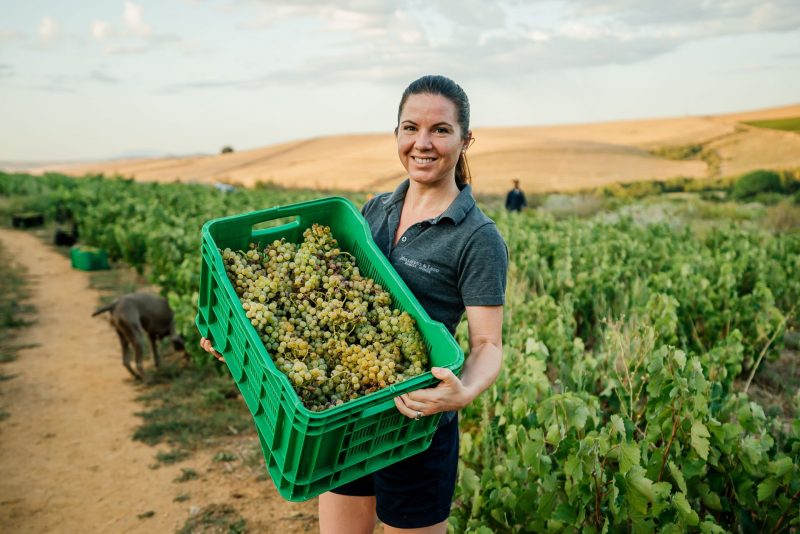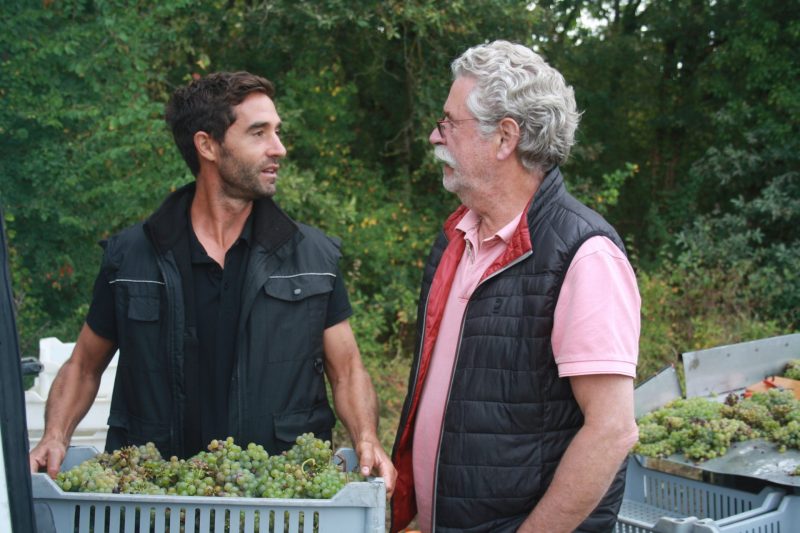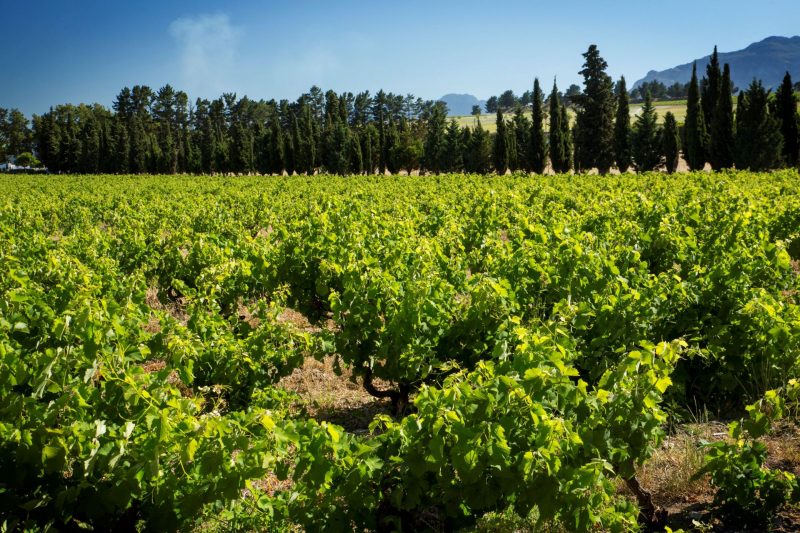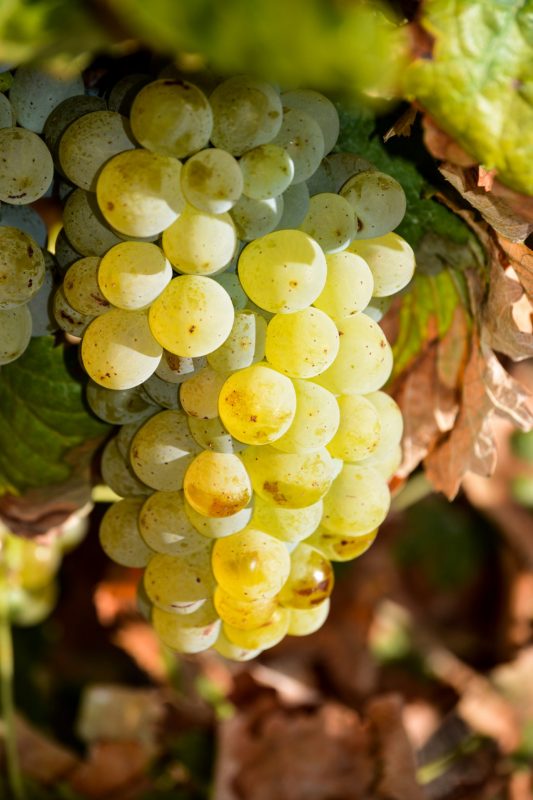This article originally appeared in the Fall/Winter 2022-2023 print issue of Quench Magazine.
The major wine grapes of the world are often grouped together under the illustrious title of noble varieties.
Chenin Blanc is notoriously absent from many such lists. And yet, this most versatile of white cultivars has more than enough merit to warrant its place on the honour roll.
No other white variety quite matches Chenin Blanc in terms of stylistic range. From dry to sweet, sparkling to still, unoaked to barrel matured, conventional to natural, white to orange, Chenin does it all and (in the right hands) does it well.
Chenin Blanc grapes are naturally high in acidity and phenolics. When yields are kept in check and ripening is optimal, Chenin Blanc produces racy, textural wines. These hallmark features are the key behind Chenin’s ability to produce well-balanced, age worthy wines in such a myriad of styles.
THE VINE OF ANJOU
A descendant of the Savagnin variety, Chenin Blanc has been cultivated in the Loire Valley for over a thousand years. Native to Anjou, the grape was originally called Plant d’Anjou (vine of Anjou), and later Pineau de la Loire. The name Chenin Blanc is thought to have emerged at the Montchenin monastery in Touraine, a likely tale given the importance of the monastic orders in proliferating plantings throughout Anjou-Saumur and Touraine from the Middle Ages onwards.
The reputation of Loire Chenin Blanc was forged by the Kings of France. When Henry II Plantagenet, Count of Anjou, became King of England in 1154 he only allowed Anjou wines at court. This spurred a fashion that spanned centuries among the French nobility as the grand châteaux of the Loire sprang up.
GLOBAL EXPANSION AND FALL FROM GRACE
In 1655, the intrepid Chenin Blanc took to the high seas, destined to become the most planted white wine grape in South Africa. For the next three hundred years, Chenin Blanc was referred to as Steen, potentially as it came to form the hoeksteen (Afrikaans for cornerstone) of the South African wine industry. It wasn’t until the 1960s that the University of Stellenbosch determined that Steen and Chenin Blanc were one and the same.
The late 18 to mid 19 hundreds marked a shifting of the tides for Chenin Blanc. After Phylloxera, and two grueling world wars, the young Loire Valley farmers left the countryside in droves to work in factories. Meanwhile, in South Africa, trade embargos imposed during the apartheid era cut the nation off from international trade.
In both cases, the vineyards suffered. Overcropped and under tended, Chenin Blanc produced thin, acidic wines in the cool Loire Valley, often masked by a healthy measure of residual sugar. Fruitier, yet equally insipid wines became the norm in warmer South Africa. At the same time, this propensity for high vigour and crisp acidity led Chenin Blanc to become the star grape in California’s innocuous “Chablis” jug wines.

CHENIN BLANC QUALITY REVIVAL
By the turn of the century, California plantings of Chenin Blanc had begun to dwindle. However, in South Africa and the Loire Valley the efforts of a determined few brought about a Chenin Blanc renaissance.
“People thought I was crazy when I started out in Montlouis,” recounts Jacky Blot of Domaine de la Taille aux Loups. Now common practice for quality-focused Loire Chenin producers, his approach of low yields, organic farming, hand harvesting, and barrel fermenting Chenin Blanc was revolutionary in the late 1980s.
In Stellenbosch, Ken Forrester’s championing of Chenin Blanc, especially its older vine plantings, also puzzled many growers who farmed the grape for quantity not quality, routinely uprooting older, less productive vines. Now “South Africa has the highest concentration of old vine Chenin Blanc in the world,” recounts Swartland winemaker Andrea Mullineux of Mullineux & Leeu Family Wines.
Mullineux refers to the grape as a “natural survivor,” referencing the process of natural and massal selections over the years, and the work of Rosa Kruger’s Old Vine Project. Today, South Africa’s 2000 hectares of old Chenin Blanc bush vines are highly sought after by winemakers for the depth and textural richness they bring.
A CHAMELEON OF TERROIR
In the Loire Valley, the sweet, often botrytised wines of Anjou-Saumur appellations such as Bonnezeaux, Quarts-de-Chaume, and Coteaux du Layon once represented the heights of Chenin Blanc quality. Now, dry wines of equally revered calibre are the focus of the region and neighbouring Touraine.
This shift has revealed the marked terroir differences across the area. Indeed, the schist soils of Savennières produce far steelier, more structured wines than the chalky tuffeau of Vouvray. In Montlouis, biodynamic vigneron François Chidaine was an early adopter of single vineyard bottlings, showcasing the diversity of clay, sand, flint, and limestone rich soils across the appellation.
“Chenin Blanc is a real chameleon of terroir,” agrees Mullineux. This realization led her to produce four separate Chenin Blanc from their Swartland vineyards. The first was a firm, flinty expression on decomposed granite soils, the second a riper, more phenolic expression from a schist terroir, the third a concentrated, textural bottling from iron-rich gravelly clay. Finally, Mullineux produced a racy, mineral-laced Chenin Blanc grown on quartz.

MONTLOUIS ON THE ROCK
In July 2022, Chenin Blanc specialists from South Africa, Spain, the Pacific Northwest, and France’s Limoux region joined local producers for Montlouis on the Rock, a Chenin Blanc celebration organized by the Vins de Montlouis-sur-Loire growers’ association.
The day-long event included comparative tastings and discussions on how to express terroir, achieve balance, and enhance overall quality across a vast range of Chenin Blanc growing regions, in an ever more challenging climate context.
Debates included the merits of oxidative handling to bring greater stability and textural appeal to wines vs. reductive winemaking techniques for finesse, as well as the relative importance of continuing to block malolactic fermentation with falling malic acid levels and greater frequency of spontaneous malolactic conversion.
Montlouis producers discussed the latest improvements in barrel fermentation and aging with the advent of the chauffe blonde technique of long, slow, low heat barrel toasting. These barrels provide gentle micro-oxygenation without overpowering Chenin Blanc’s vibrant fruit and floral aromas.
Extended skin contact techniques, efforts to limit or eliminate sulphur, varying practices in Pét Nat production, and experimentation with different ageing vessels were all shared, with an impressive array of wines demonstrating each style.
The visiting winemakers at Montlouis on the Rock 2022
Thomas Monroe, Division Wine Co. (Portland, Oregon)
In 2010, Thomas Monroe set up Division Wine Co. with partner Kate Norris. The négociant winery sources organic and biodynamic grapes from across Oregon and Washington. Monroe shared his experience coaxing quality Chenin from this arid environment, with its ever-increasing challenges of combating smoke damage.
Craig Hawkins, Testalonga (Swartland, South Africa)
In 2007, Craig and Carla Hawkins set up Testalonga in the Swartland. The skin macerated wines of Ligurian master Antonio Perrino inspired the Hawkins’ winery name and approach. Years of experimentation with different vessels, oxygen ratios, and fermentation techniques has given Hawkins a wealth of experience in producing structured, textural Chenin Blanc on his beloved decomposed granite soils.
José Luis Matéo, Quinta da Muradella (Monterrei, Spain)
Agudelo (aka Chenin Blanc) is a rare grape in Galicia, used in blends for its vibrant acidity. José Luis Matéo was so enamoured with the quality that he decided to produce a monovarietal wine. Over the past 30 years, faced with a steady rise in regional summer temperatures, Matéo has gained significant expertise in adapting Chenin Blanc winemaking techniques.
Thomas Fort, Domaine Mouscaillo (Limoux, France)
Chenin Blanc is an important blending element for Domaine Mouscaillo’s still and sparkling Limoux wines, bringing freshness and verve. Domaine Mouscaillo’s location, perched in the clay-limestone foothills of the Pyrenees, gives uniquely ripe, yet lively Chenin Blanc with distinctive florality.

Ken Forrester’s FMC Vineyard 
Chenin Blanc grape bunch | photos courtesy of Ken Forrester
THE FUTURE OF CHENIN BLANC IN AN EVOLVING CLIMATE
While the specific climate challenges were different in each area, all growers at the Montlouis conference spoke of the increasing frequency of erratic and extreme weather events. Smoke taint, hydric stress, frost and hail damage, rot, and the arrival of never seen before vineyard pests were just some of the many issues raised.
Despite these growing threats, the mood among producers was optimistic. They were there to share solutions and work collaboratively. The sense of community, among Montlouis growers, and extended to international guests, was infectious.
As the quality and stylistic diversity of Chenin Blanc continues to increase, so does the grape’s fan base around the world. Once a grape most commonly found on supermarket shelves or dessert wine lists, Chenin Blanc is now the darling of trendy wine bars.
South Africa and France continue to dominate worldwide plantings, but small quantities of excellent Chenin Blanc are emerging from Argentina, Australia, Spain, New Zealand, California, Canada, Chile and beyond, bringing ever more stylistic range and quality focus to this most noble white grape.
Increasing frequency of frost/erratic weather in Loire and how Montlouis producers are reacting
In recent years, wine grape growers across France have witnessed an alarming acceleration of vegetative cycles. According to a 2021 study by the World Weather Attribution initiative, climate change is to blame.
Average winter temperatures are warming, leading to an earlier start to the growing season. This puts early budding varieties, like Chenin Blanc, at greater risk. April frosts are hardly a new phenomenon in the Loire Valley. However, in the past, the tender buds were less often exposed.
Over half of Montlouis-sur-Loire vintages in the past decade have suffered significant frost damage. “We have had to learn how to act, rather than simply react” explained Ludovic Chanson at the recent Montlouis on the Rock conference.
At La Grange Tiphaine, this meant investing in fixed and mobile wind turbines. According to Damien, within a few short vintages they had already paid for themselves. “The spring frosts were particularly bad in 2021,” he said. “Many neighbours lost up to 70% of their yields. My losses were less than 30%.”
Many of Montlouis’ smaller producers, like Domaine Thet and Domaine les Pierres Ecrites, are members of groups that share vineyard equipment. This collaborative arrangement has allowed for the purchase of units to cover multiple vineyard sites.
In 2017, Montlouis-sur-Loire newcomer Laura David lost over half of her first vintage. When frost struck again in 2019, followed by a mid-summer heatwave, David’s vines struggled to ripen. “I wanted to make single terroir wines, but certain parcels were excessively acidic, others had a vegetal bitterness,” she explained.
David decided to abandon her initial plan and instead make one blend which she labeled “L’insolente” (the insolent one). The wine received a highly positive response and taught David an important lesson. “I couldn’t afford to lose another vintage, so I was forced to adapt.”
Tasting Notes
La Grange Tiphane Les Epinay 2020, Montlouis-sur-Loire France
Grown on sandy clay soils veined with flint, the Epinay cuvée is fermented slowly throughout the winter in neutral barrels and casks, and aged in a mix of foudres, amphora, and concrete eggs. Enticing notes of lanolin, oatmeal, red apple, and honeysuckle leap from the glass, gaining in complexity with aeration. Brisk acidity balances the weighty, textural palate, elongating the juicy, spiced finish.
François Chidaine Rive Gauche 2020, Montlouis-sur-Loire France
The partially botrytised Rive Gauche cuvée is sourced from three different vineyard sectors, vinified separately and then blended during ageing. Fragrant notes of spiced apple tart and honey are underscored by hints of lanolin, giving significant complexity to the nose. The palate’s weighty core and luscious sweetness are seamlessly balanced by its vibrant freshness.
Domaine de la Taille aux Loups Triple Zéro, Montlouis-sur-Loire France
Triple zéro means no chaptalisation, no added yeast, and no dosage. The wine spends seven to eight months in barrel before transfer to bottle at 12 grams/litre residual sugar, where it completes fermentation over three years or more. The latest cuvée is mainly sourced from the ripe 2019 vintage. Delicate notes of bruised apple, brioche, and underbrush on the nose. The palate is lively and elegant, with its fine bubbles and silky, dry finish.
Domaine les Pierres Ecrites « Empreintes » 2019, Montlouis-sur-Loire France
New to Montlouis, Anthony and Coralie Rassin have quickly gained a following for their organic, minimal interventionist wines crated in a very precise style. Discreet chamomile and yellow apple aromas give way to hints of quince with aeration. The palate is racy and linear, with vivid citrus and apple flavours. Appealing saline notes linger on the finish.
Domaine Laura David L’Insolite 2019, Montlouis-sur-Loire France
Assailed by frost and mid-summer heat, recently arrived Montlouis vigneronne Laura David decided to blend her various vineyard plots to produce one cuvée. Aromas and flavours of baked yellow fruits, raw honey, and baking spice are offset by bright, tangy acidity. The palate is broad and subtly earthy with refreshing citrus pith bitters on the finish.
Mullineux Old Vines White 2020, Swartland South Africa
This Chenin Blanc dominant blend is sourced from schist, granite, and iron-rich vineyards across the Swartland. The wine is fermented and aged in large, neutral oak casks. Pretty aromas of white blossoms, orchard fruit, and flint feature on the nose. The palate is rich, yet steely, with a concentrated core of tangy fruit and subtle savoury flavours that persist on the dry finish.
Reyneke Organic Chenin Blanc 2020, Stellenbosch South Africa
The organic grapes for this cuvée are sourced from a hot, semi-arid area of Stellenbosch, on loamy soils. Wild yeast fermentation and subsequent lees ageing takes place in stainless steel at cool temperatures. Quite an aromatic expression, with exuberant notes of honey, quince, and yellow apple. The palate is plush and rounded, bookended by bright acidity and refreshing citrussy bitters that lengthen the finish.
Beaumont Wines Chenin Blanc 2021, Bot River South Africa
With its close proximity to the Atlantic Ocean, Bot River enjoys a long, slow ripening season. The Chenin Blanc vines here grow on deep, shale soils. Vivid orange marmalade, lime blossom, and wild thyme notes emerge on the nose, in perfect harmony with the wine’s bracing acidity and light bodied, precise palate.
Ken Forrester “The FMC” 2020, Stellenbosch South Africa
An icon wine from Ken Forrester, the FMC hails from well-drained soils of decomposed granite and clay. This Chenin Blanc is barrel fermented and aged for on lees in new and one-year French oak barriques. Very opulent, full-bodied Chenin Blanc with its rich, creamy core and perfumed notes of acacia, yellow peach, toasted oak spice. Fresh acidity lifts the palate and lengthens the fruity, textural finish.
Testalonga “Stay Brave” 2021, Swartland South Africa
The Stay Brave Chenin Blanc is in deep rooting schist soils, giving small, thick-skinned berries. Two weeks of skin contact is followed by a long, slow native yeast fermentation in large vats. Initially savoury flavours give way to appealing citrus peel, baking spice, and quince notes. A complex, vibrant white of medium body, with subtle citrussy bitters and lingering malted nuances.
Division Wine Co. Chenin Blanc “Inondé” 2020, Willard Farms Columbia Valley, Washington
This hot, arid sector of the Columbia Valley experiences significant diurnal shifts, allowing for excellent acid retention in these organically farmed Chenin Blanc grapes. Aromas of preserved lemon, white grapefruit, and elderflower on the nose. The palate is crisp and initially firm, broadening across the smooth, rounded mid-palate, then tapering to a dry, textural finish.
Quinta de Muradella Monovarietal de Agudelo 2015, Monterrei Spain
Agudelo is the local name for Chenin Blanc in Galicia. Grown on granite and slate soils, this cuvée is aged for one year in a mix of stainless steel and oak barrels. Tropical notes of guava and papaya give way to a more mineral, earthy impression as the wine develops. The medium weight palate is dry and firm in structure, with a precise, clean finish and gentle bitters.
Jacky Blisson MW is an independent wine educator, writer, and consultant with over two decades experience in all facets of the global wine trade. She is the first Master of Wine in Québec and one of only ten across Canada. After studying wine science and commerce in Beaune France, Jacky managed exports for Burgundian and Rhône Valley firms. She also worked harvest seasons in Beaune and Walker Bay, South Africa. Jacky produces a self-titled wine website and YouTube channel. Her go-to restaurant that never disappoints is L’Express in Montréal and the best concert she ever attended was The Tragically Hip on New Year’s Eve 2000.


